Introduction
In the realm of C programming, pointers play a pivotal role as invaluable tools that enable us to efficiently manage memory and manipulate data. However, the terminology surrounding pointers can sometimes become perplexing, especially when dealing with two fundamental concepts: “Constant Pointer” and “Pointer Constant.”
In this blog post, our primary focus is to elucidate the distinctions between Constant Pointers and Pointer Constants, shedding light on their unique definitions, practical applications, and how they wield influence over the behavior of our code.
By gaining a clear understanding of these disparities, developers can elevate their code-writing skills, crafting more dependable and efficient solutions while harnessing the full potential of pointers within their C code.
Grasping the nuances between a constant pointer and a pointer to constant proves to be pivotal for achieving mastery in C programming.
When working with C programming, it’s essential to understand various concepts, including enumeration. If you’re looking to deeper into this topic, consider reading our blog post on Enumeration in C.
What is a Constant Pointer?
A pointer that cannot change the address it is containing. In other words, we can say that once a constant pointer points to a variable address then it cannot point to any other variable address.
To put it simply, a constant pointer is a pointer in C programming that has a fixed memory address and cannot be reassigned to point to a different memory location after its initialization. Once a constant pointer is assigned a memory address, it remains bound to that address throughout its lifetime.
1. Declaration of Constant Pointer
It can be declared by applying the const qualifier, before the variable name. By applying the const before the variable name it will make it a constant pointer.

Example :

2. Constant Pointer Illustration
Let us consider the code snippet, pretty much similar in the lines of what we saw in the pointer constant section above.
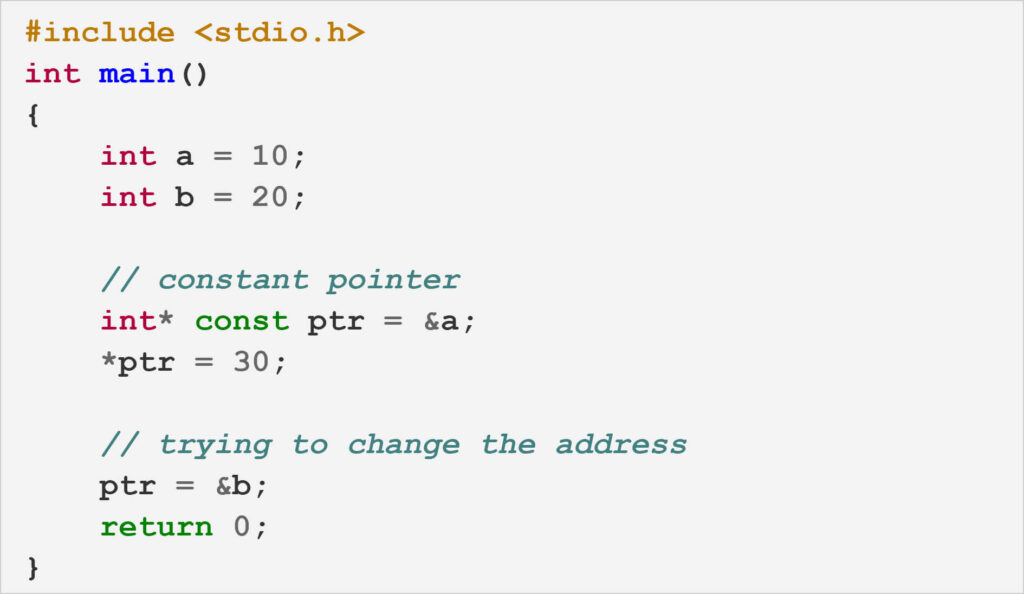
As you can see in the code, there are two variables a and b having values of 10 and 20 respectively. Now a constant pointer ptr is made to point to variable a. After making to point, the value of a can be changed via ptr by making *ptr = 30.
On the other hand ptr cannot be made to point to another address location of a variable b, hence this code will give an error.
Output :

This can be clearly understood by the pictorial representation given below.
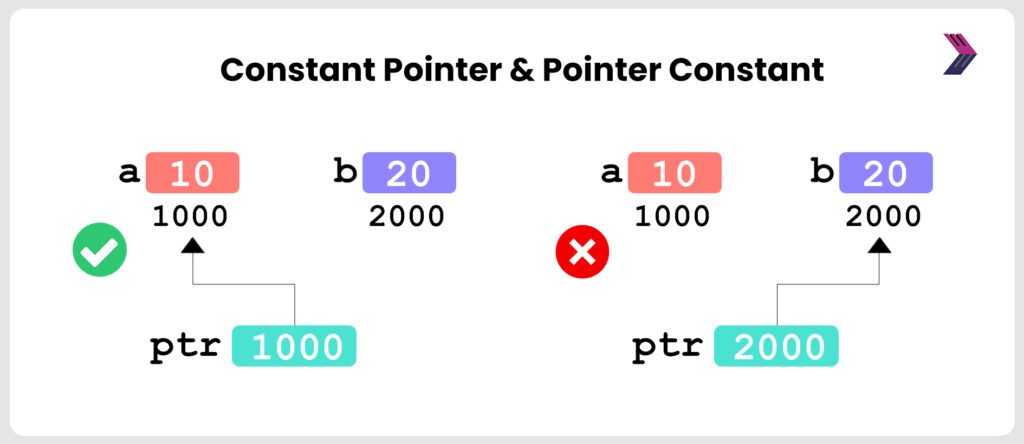
3. Constant Pointer - Summary
- The value the pointer points to can be changed.
- The address the pointer holds cannot be changed
This was illustrated in the code examples given above.

What is Pointer to Constant ?
A pointer to constant (also referred to as “constant data”) is a pointer that points to a memory location whose value cannot be changed through the pointer. However, the pointer itself can be modified to point to a different address.
1. Declaration of Pointer to Constant
The pointer constant can be declared by applying the const qualifier, before the regular pointer declaration. By applying the const before the data type it will make it as a pointer constant.
const data_type * ptr_name
Example :

2. Pointer Constant Illustration
Let us consider the code snippet below to understand how pointer constant works. As you can see there are two variables a and b along with a pointer constant named as ptr. The pointer constant is made to point to variable a by assigning its address.
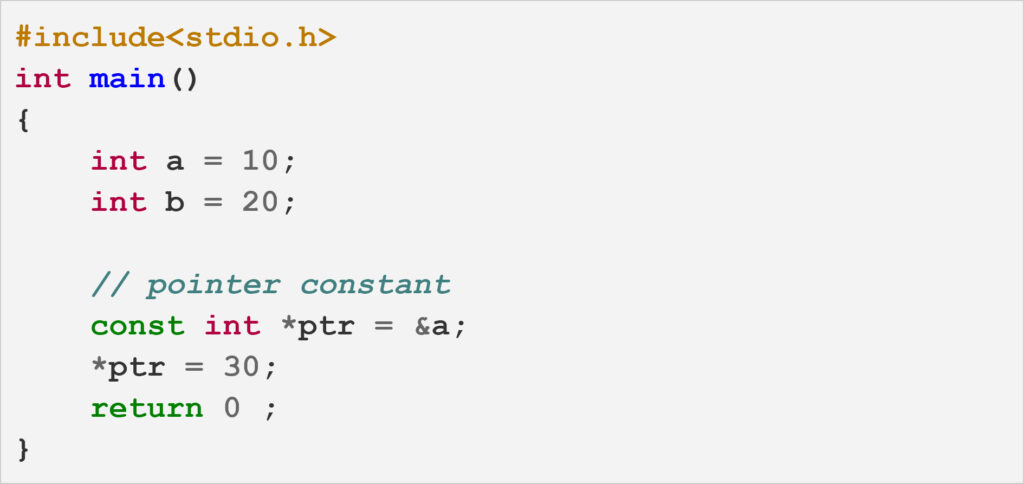
When you compile and run the code you will be getting a compilation error as follows.
Output :

In the above given code, we have declared pointer to constant. Which means the data that is pointing to cannot be changed. Initially we assign it to point to the address of an integer variable a, say for example 1000.
Later when we try to alter it by assigning a constant value of 30 which is stored in a different location, it is not acceptable as per the pointer constant. Hence the compiler is giving an error.
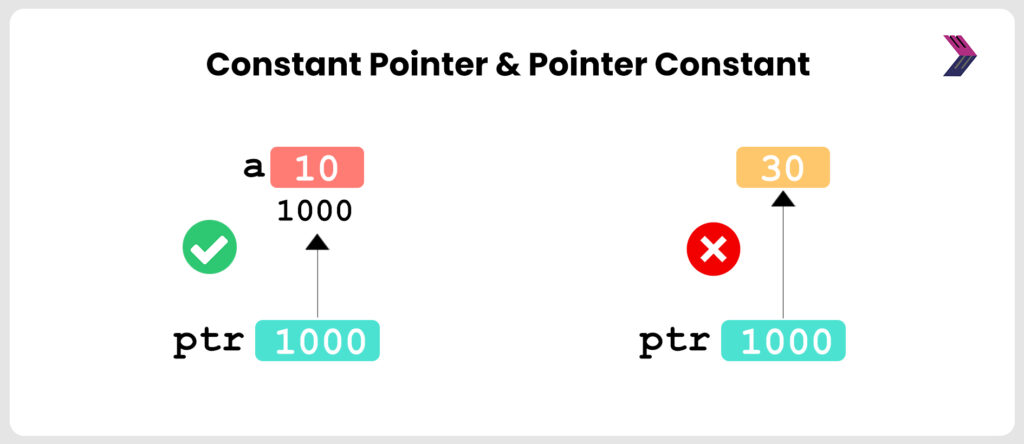
On the other hand, we can change the address of the pointer constant, where it is pointing to. Please refer to the code snippet given below.
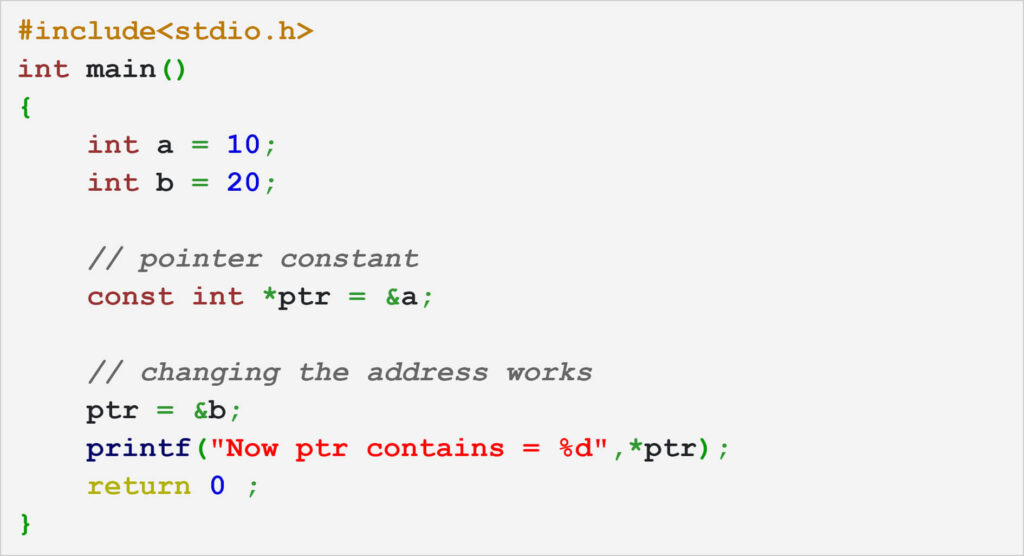
Let us consider two variables a and b having values of 10 and 20. Assume they are stored in address locations 1000 and 2000 in the memory respectively.
Initially the pointer constant ptr is made to point to variable a, thereby having the value of 1000 inside the pointer variable ptr. Now the ptr can be modified to point to another variable b thereby having a value of 2000.
This means the address contained in the pointer constant can be changed from 1000 to 2000 but not the value it is pointing to.
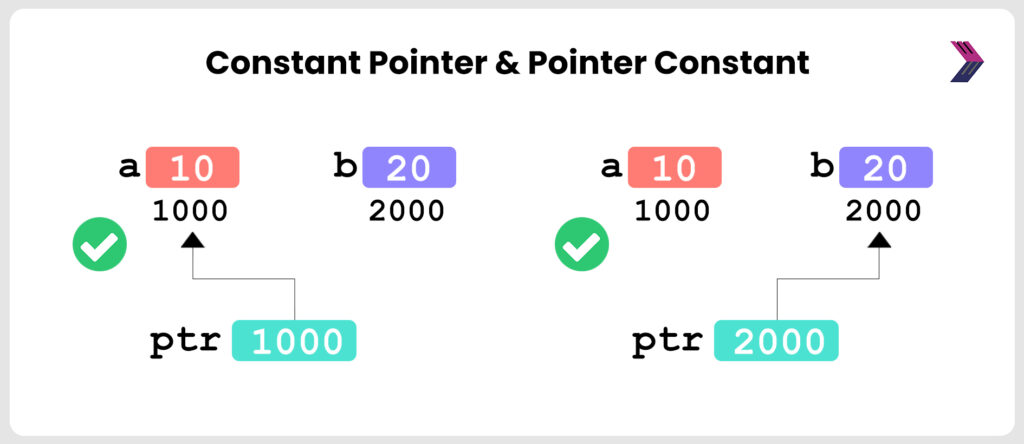
When you run the program you will get the proper output as given below. As you can see it gives a proper output as the address can be changed.
Output :

3. Pointer Constant - Summary
- The value the pointer points to cannot be changed.
- The address the pointer holds can be changed.
This was illustrated in the code examples given above.

Practical Applications of 'const' in C Programming
1. Function Parameters:
- Used to prevent accidental modification of data.
void printString(const char *str) {
printf(“%s”, str);
}
2. Immutable Global Variables:
- Used to define constants.
const float PI = 3.14;
- Used to define constants.
3. Embedded Systems:
- Used to access hardware registers safely.
const volatile uint8_t *port_status = (uint8_t *)0x4000;
- Used to access hardware registers safely.
4. Returning Read-Only Data:
- Ensuring function returns immutable strings.
const char* get_message() {
- Ensuring function returns immutable strings.
return “Hello, World!”;
}
5. Defining Lookup Tables:
- Prevents accidental changes to critical data.
const int lookup_table[] = {10, 20, 30, 40};
Conclusion
Understanding the differences between constant pointers and pointers to constants is crucial for effective pointer management in C programming. By utilizing these concepts correctly, developers can:
- Enhance code readability and maintainability.
- Ensure data integrity and avoid accidental modifications.
- Improve memory management practices, especially in embedded systems.
Mastering these concepts allows developers to create efficient, secure, and reliable C programs, ensuring better memory management and stable software solutions.
In summary, mastering pointers not only simplifies working with pointers in C but also enhances a programmer’s overall skill set. Armed with this knowledge, programmers can create solutions that combine reliability and efficiency, unlocking the full potential of pointers in all their programming endeavors.
If you’re looking to enhance your skills in C programming, our comprehensive guide on Emertxe’s Online Training Programs in Embedded Systems & IoT can provide valuable insights and resources.
| SN | Blogs | Links |
|---|---|---|
| 1. | Enumeration in C | Click Here |
| 2. | Type Promotion in C | Click Here |
| 3. | Difference between typedef and macro in C | Click Here |
People Also Ask(PAA)
If you attempt to modify the address stored in a constant pointer, you’ll encounter a compilation error. Constant pointers are designed to have a fixed memory address, which means that once they are assigned a specific address, that address cannot be changed. Any attempt to reassign a new address to a constant pointer will result in a compilation error, indicating that the pointer is read-only and its address cannot be modified.
Pointer constants contribute to the clarity of the code by indicating that the memory address won’t change, enhancing readability, and clarifying intentions. Contribution of constant pointer is it Increase code maintainability by preventing accidental reassignment, reducing the risk of errors and improving long-term stability.
Advantages of using pointer constants In order to facilitate predictable hardware interactions, ensure memory address stability. Constant pointers provide the advantage of protecting against unintentional modifications and improving code stability.Together, they advocate for reliable, effective code for embedded systems that are resource-constrained.
